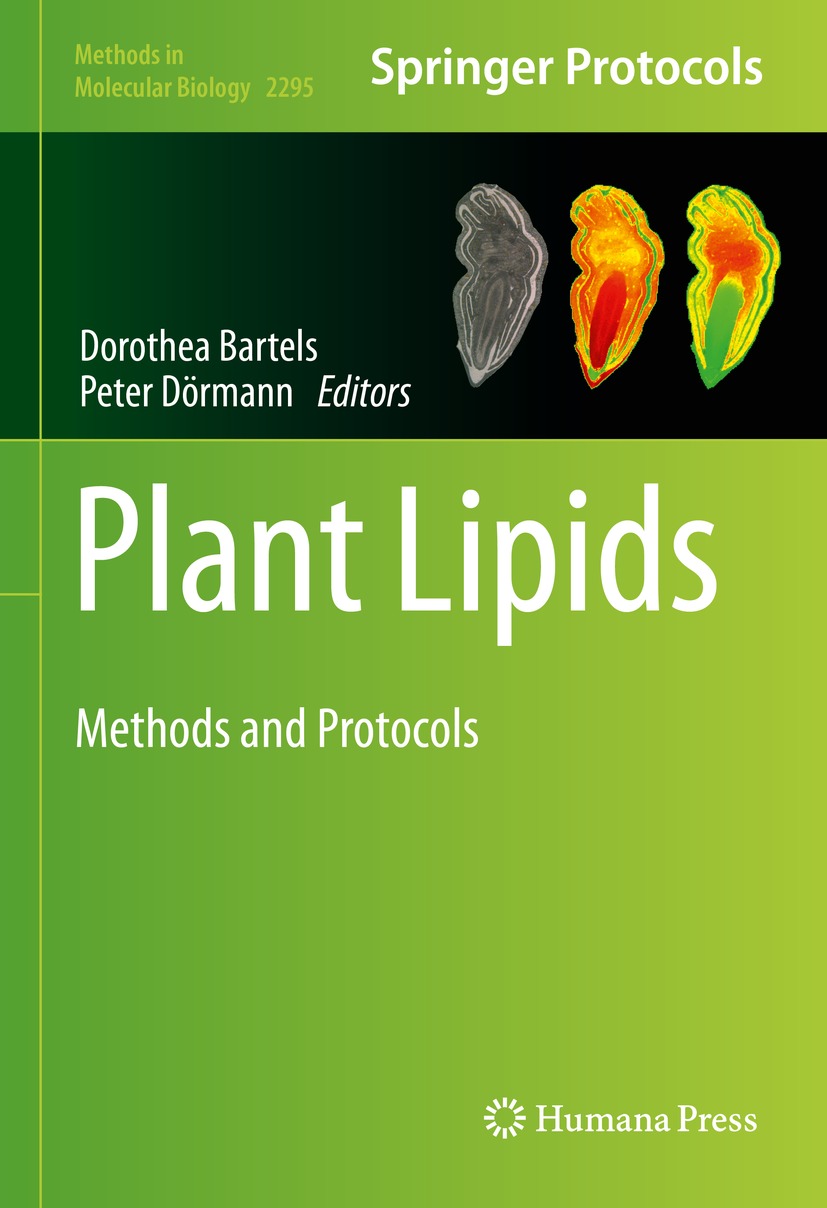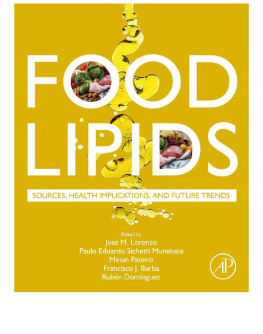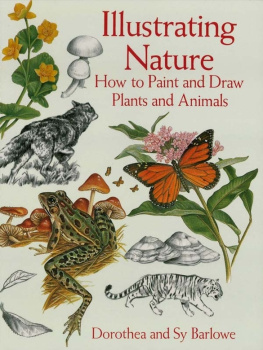Dorothea Bartels - Plant Lipids
Here you can read online Dorothea Bartels - Plant Lipids full text of the book (entire story) in english for free. Download pdf and epub, get meaning, cover and reviews about this ebook. year: 2021, publisher: Humana, genre: Home and family. Description of the work, (preface) as well as reviews are available. Best literature library LitArk.com created for fans of good reading and offers a wide selection of genres:
Romance novel
Science fiction
Adventure
Detective
Science
History
Home and family
Prose
Art
Politics
Computer
Non-fiction
Religion
Business
Children
Humor
Choose a favorite category and find really read worthwhile books. Enjoy immersion in the world of imagination, feel the emotions of the characters or learn something new for yourself, make an fascinating discovery.
- Book:Plant Lipids
- Author:
- Publisher:Humana
- Genre:
- Year:2021
- Rating:4 / 5
- Favourites:Add to favourites
- Your mark:
- 80
- 1
- 2
- 3
- 4
- 5
Plant Lipids: summary, description and annotation
We offer to read an annotation, description, summary or preface (depends on what the author of the book "Plant Lipids" wrote himself). If you haven't found the necessary information about the book — write in the comments, we will try to find it.
Plant Lipids — read online for free the complete book (whole text) full work
Below is the text of the book, divided by pages. System saving the place of the last page read, allows you to conveniently read the book "Plant Lipids" online for free, without having to search again every time where you left off. Put a bookmark, and you can go to the page where you finished reading at any time.
Font size:
Interval:
Bookmark:

For further volumes: http://www.springer.com/series/7651
For over 35 years, biological scientists have come to rely on the research protocols and methodologies in the critically acclaimed Methods in Molecular Biology series. The series was the first to introduce the step-by-step protocols approach that has become the standard in all biomedical protocol publishing. Each protocol is provided in readily-reproducible step-by step fashion, opening with an introductory overview, a list of the materials and reagents needed to complete the experiment, and followed by a detailed procedure that is supported with a helpful notes section offering tips and tricks of the trade as well as troubleshooting advice. These hallmark features were introduced by series editor Dr. John Walker and constitute the key ingredient in each and every volume of the Methods in Molecular Biology series. Tested and trusted, comprehensive and reliable, all protocols from the series are indexed in PubMed.

Cover Caption: Mass spectrometry (MS) imaging of phosphatidylcholine (PC) from a cotton (Gossypium hirsutum, variety Coker 312) embryo. From left to right: light microscopy image of section used in MS imaging (scale bar = 1 mm), PC 34:2 (max mol% = 55), PC 36:3 (max mol% = 35), colorimetric scale bar representing mol% from green (low) to red (high).
This Humana imprint is published by the registered company Springer Science+Business Media, LLC part of Springer Nature.
The registered company address is: 1 New York Plaza, New York, NY 10004, U.S.A.
Lipids have diverse roles in plant cells such as establishing the membrane bilayer or serving as energy storage or signaling molecules. Acyl lipids are the most abundant group of lipids and represent a structurally broad family of fatty acid-derived compounds. In addition, plants contain considerable amounts of sterol lipids and sphingolipids which are mainly found in the plasma membrane, and they have been implicated in developmental and defense-related processes. The compartments of the plant cell are characterized by the occurrence of specific lipid classes, and each plant tissue has its specific lipid profile. In accordance with their functions, lipids are present in very different amounts in the cells, ranging from highly abundant structural and storage lipids to minor amounts in the case of signaling lipids. Many lipid classes like membrane glycerolipids and triacylglycerol are characterized by the existence of numerous molecular species with characteristic fatty acid patterns. The abundance of the molecular species of a lipid class represents an important consideration to determine the strategy for their analysis.
The focus of this protocol series is on analytical methods to study complex lipid mixtures from plants and algae. This book has assembled 26 chapters, which all together cover a broad range of state-of-the-art methods and technologies. Isolation of lipids from plants requires special care because these molecules are highly nonpolar, they require organic solvents for extraction, and lipase activities need to be inhibited to prevent lipid degradation. Thin-layer chromatography represents a well-established technique for obtaining an overview of the composition of a crude lipid extract. Many lipids including fatty acids can be derivatized to increase their volatility for analysis by gas chromatography (GC) or gas chromatography-mass spectrometry (GC-MS). Lipidomics is an emerging technology which involves the structural identification and quantification of the molecular species of a lipid class in a whole plant organ or in a tissue. Progress in lipidomics has been driven in particular by advances in mass spectrometry (MS). Two alternative strategies are currently employed for high-throughput lipid analyses, i.e., direct infusion MS (shotgun lipidomics) and liquid chromatography-mass spectrometry (LC-MS). Furthermore, imaging methods based on MALDI-MS techniques have been developed to localize different lipids to the tissue level. Next to MS, nuclear magnetic resonance (NMR) spectroscopy represents a highly important technique for structural analysis of lipids. Different protocols have been developed for the isolation and characterization of lipids from specific tissues or subcellular compartments. Two chapters describe the isolation and quantification of extremely low abundant signaling lipids of the phosphoinositide family. While the analysis of interactions of lipids with proteins is a highly important research field for systems biology and for putting lipids in a metabolic context, these methods are covered in only two chapters and we refer here to protocols in other publications including this series. Analyses of mutants and genomic sequences of plants and algae have contributed toward elucidating lipid biosynthesis pathways and cellular lipid interaction networks. Therefore, overviews are presented on lipid databases, which include lipid structural information and pathway analyses.
All chapters have been written by experts in the field, and the methods have been optimized and thoroughly tested in the respective laboratories. The methods have been designed or optimized for lipids from plants or algae. The required chemicals and equipment as well as the experimental steps are described in detail, followed by extensive troubleshooting notes. As part of the general workflow, some procedures such as lipid isolation, thin-layer chromatography, or gas chromatography are described in more than one chapter. This allows for comparisons of the methods and demonstrates the possible variations in the different laboratories. The methodologies range from simple to technically demanding approaches. Some of the simple approaches can be used for mass screening strategies of mutants, or they can be integrated into protocols for student classes. However, some methods such as MS or NMR analyses require dedicated, expensive equipment and can only be performed in specialized laboratories.
Font size:
Interval:
Bookmark:
Similar books «Plant Lipids»
Look at similar books to Plant Lipids. We have selected literature similar in name and meaning in the hope of providing readers with more options to find new, interesting, not yet read works.
Discussion, reviews of the book Plant Lipids and just readers' own opinions. Leave your comments, write what you think about the work, its meaning or the main characters. Specify what exactly you liked and what you didn't like, and why you think so.











